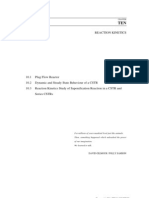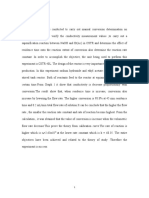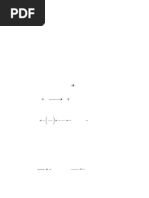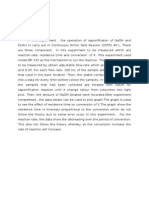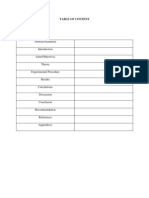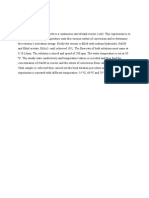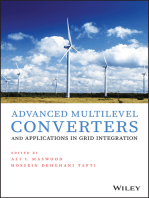Chapter 10 PDF
Chapter 10 PDF
Uploaded by
Joseph RayCopyright:
Available Formats
Chapter 10 PDF
Chapter 10 PDF
Uploaded by
Joseph RayOriginal Title
Copyright
Available Formats
Share this document
Did you find this document useful?
Is this content inappropriate?
Copyright:
Available Formats
Chapter 10 PDF
Chapter 10 PDF
Uploaded by
Joseph RayCopyright:
Available Formats
CHAPTER
TEN
REACTION KINETICS
10.1 10.2 10.3
Plug Flow Reactor Dynamic and Steady State Behavior of a CSTR Reaction Kinetics Study of Saponification Reaction in a CSTR and Series CSTRs
For millions of years mankind lived just like animals. Then, something happened which unleashed the power of our imagination. We learned to talk. DAVID GILMOUR / POLLY SAMSON
Chapter 10: REACTION KINETICS
10.1. PLUG FLOW REACTOR
Keywords: Tubular reactor, plug flow reactor, saponification, integral method, differential method.
10.1.1. Object The object of this experiment is to study the behaviour of a plug-flow reactor by performing a series of experiments on the saponification of ethyl acetate.
10.1.2. Theory In a tubular reactor, the feed enters at one end of a cylindrical tube and the product stream leaves at the other end. The long tube and the lack of provision for stirring prevent complete mixing of the fluid in the tube. Hence the properties of the flowing stream will vary from one point to another, namely in both radial and axial directions. In the ideal tubular reactor, which is called the plug flow reactor, specific assumptions are made about the extent of mixing: 1. 2. 3. no mixing in the axial direction, i.e., the direction of flow complete mixing in the radial direction a uniform velocity profile across the radius.
The absence of longitudinal mixing is the special characteristics of this type of reactor. It is an assumption at the opposite extreme from the complete mixing assumption of the ideal stirred tank reactor. The validity of the assumptions will depend on the geometry of the reactor and the flow conditions. Deviations, which are frequent but not always important, are of two kinds: 1.
2.
mixing in longitudinal direction due to vortices and turbulence incomplete mixing in radial direction in laminar flow conditions
Mass Balance For a time element t and a volume element V, the mass balance for species i is given by the following equation: QA CA v t- QA CAv+v t - rAVt = 0 where QA : volumetric flow rate of reactant A to the reactor, L/s CA : concentration of reactant A, mol/L rA : rate of disappearance of reactant A, mol/Ls The conversion, X, is defined as: X = (initial concentration - final concentration) / (initial concentration) Since the system is at steady state, the accumulation term in Equation (10.1.1) is zero. Equation (10.1.1) can be written as: -QA CA - rAV = 0 Dividing by V and taking limit as V 0 dCA/dV = -rA/QA (10.1.3) (10.1.2) (10.1.1)
This is the relationship between concentration and size of reactor for the plug flow reactor. Here rate is a variable, but varies with longitudinal position (volume in the reactor, rather than with time). Integrating, -dV/ QA = dCA/rA At the entrance: At the exit: V=0 CA = CA0 V = VR (total reactor volume) CA = CA (exit conversion) (10.1.4)
Chapter 10: REACTION KINETICS
A VR dC A = Q A C A 0 rA
(10.1.5)
10.1.3. Apparatus The apparatus used in this experiment is shown in Figures 10.1.1 and 10.1.2:
Figure 10.1.1. Chemical reactor service unit.
Figure 10.1.2. Tubular reactor.
10.1.4. Experimental Procedure 1. 2. 3. 4. 5. Prepare 5 lt of 0.05 N ethyl acetate and 0.05 N NaOH solutions. Then pour these solutions into the feed tanks. Adjust the temperature of PFR. Adjust the apparatus to constant flowrate. Record the conductivity when steady state is reached. Repeat the same procedure for different flowrates.
10.1.5. The Conductivity and Concentration Relations It has been determined that the degree of conversion of the reagents affects the conductivity of the reactor contents so that recording the conductivity with respect to time helps to calculate the amount of conversion with the help of formulas that are provided below.
C A0 =
QA C tan k1 Q A + QB
CB0 =
QB C tank2 Q A + QB
(10.1.6)
where A=NaOH, B=EtAc in the reaction: C = CB0 C = CA0 for for CB0 < CA0 CB0 CA0
A+BC+D
C = 0.070 C [1 + 0.0284(T-294)] CA0 = 0.195 CA0 [1 + 0.0184(T-294)] 0 = CA0 CA = 0 CA = CA0 - CB0 assuming C0 = 0 for for CA0 < CB0 CA0 CB0
for T 294K for T 294K
(10.1.7) (10.1.8)
CA = 0.195 CA [1 + 0.0184(T-294)] = C + CA
if CA0 0.
(10.1.9) (10.1.10)
Chapter 10: REACTION KINETICS
CA=(CA - CA0) ( CC= CC ( XA=
0 1 )+ CA0 0
for CC0 = 0
(10.1.11) (10.1.12) (10.1.13)
0 1 ) 0
CA0 CA CA 0
10.1.5. Report Objectives You may assume that the saponification reaction of ethyl acetate with NaOH is overall second order. 1. 2. 3. Evaluate the data using the Integral Method. Calculate conversion. Evaluate the rate constant using the Differential Method. Compare the results of the two methods.
10.1.6. References 1. 2. 3. 4. Denbihh, K. G., and J. C. R. Turner, Chemical Reactor Theory, 2nd edition, Cambridge University, 1971. Levenspiel, O., Chemical Reaction Engineering, 2nd edition, John Wiley and Sons, 1972. Perry, R. H., and D. Green, Perrys Chemical Engineers Handbook, 6th edition, McGrawHill, 1984. Smith, J. M., Chemical Engineering Kinetics, 3rd edition, McGraw-Hill, 1981.
10.2. DYNAMIC AND STEADY STATE BEHAVIOR OF A CSTR
Keywords: Continuous stirred tank reactors, saponification, mathematical modeling, differential equations.
10.2.1. Object The object of the experiment is to study the dynamics of a CSTR during different stages of its continuous operation by using the saponification of ethyl acetate reaction. 10.2.2. Theory Continuous stirred tank reactors are used very commonly in industrial processes. For this type of reactor, mixing is complete, so that the temperature and the composition of the reaction mixture are uniform in all parts of the vessel and are the same as those in the exit stream. Three stages of the continuous operation of a CSTR can be modeled. 1. 2. 3. From beginning to overflow From overflow to steady state Steady state operation
The first and second stages are transient and they produce differential equations. The third stage is represented by a steady state model which contains algebraic equations. Stage One This stage is semibatch. There is no output because the reactor contents do not yet reach the overflow level. A material balance on either NaOH or ethyl acetate (both reactants are at the same concentration and flow rate) gives: rate of accumulation = rate of input - rate of consumption d ( VC) = FC 0 VkC 2 dt or
(10.2.1)
Chapter 10: REACTION KINETICS
dC dV +C = FC 0 VkC 2 dt dt
(10.2.2)
But V is a function of time, and since the system is of constant density and flow rate, a total mass balance gives: dV =F dt since at t = 0, V = 0. Equation (10.2.2) becomes dC C 0 C = kC 2 dt t t Equation (10.2.3) is subject to C = C 0 at t = 0 . Stage Two The second stage is continuous but not yet steady. The concentration is changing with time but the volume of the reactants is constant. A material balance takes the form: rate of accumulation = rate of input - rate of output - rate of consumption dC = FC 0 FC kVC 2 dT or
V = Ft
(10.2.3)
V and therefore
(10.2.4)
dC C 0 C = kC 2 dT where
(10.2.5)
T=t = V/F
is time in minutes and is time constant.
At steady state, C = C s , which is a particular solution to Equation (10.2.5).
Stage Three This is the easiest stage to model. A material balance requires that rate of input = rate of output + rate of consumption
FC 0 = FC s + kVC s 2 kC s 2 + C s C 0 = 0
10.2.2.1. The Conductivity and Concentration Relations
(10.2.6)
(10.2.7)
It has been determined that the degree of conversion of the reactants affects the conductivity of the reactor contents so that recording the conductivity with respect to time helps to calculate the amount of conversion with the help of formulas that are provided below.
C A0 =
QA C tan k1 Q A + QB
CB0 =
QB C tank2 Q A + QB
(10.2.8)
where A=NaOH, B=EtAc in the reaction: C = CB0 C = CA0 for for CB0 < CA0 CB0 CA0
A+BC+D
C = 0.070 C [1 + 0.0284(T-294)] CA0 = 0.195 CA0 [1 + 0.0184(T-294)] 0 = CA0 CA = 0 CA = CA0 - CB0 assuming C0 = 0 for for CA0 < CB0 CA0 CB0
for T 294K for T 294K
(10.2.9) (10.2.10)
CA = 0.195 CA [1 + 0.0184(T-294)] = C + CA
if CA0 0.
(10.2.11) (10.2.12)
Chapter 10: REACTION KINETICS
CA=(CA - CA0) ( CC= CC ( XA=
0 1 )+ CA0 0
for CC0 = 0
(10.2.13) (10.2.14) (10.2.15)
0 1 ) 0
CA0 CA CA 0
To calculate the specific rate constant k, the overall mass balance may be written as: Rate of change within the reactor = Input Output + Accumulation i.e. for a reactant A in a reactor operating at steady state the volume may be assumed constant and the steady state concentration of NaOH in the reactor (CA) may be used to calculate the specific rate constant (k). (Q A + QB ) (C A0 C A ) 2 V CA
k=
L / mol.s
(10.2.16)
10.2.3. Apparatus The apparatus used in this experiment is shown in Figures 10.2.1 and 10.2.2.
Figure 10.2.1. Chemical reactor service unit.
Figure 10.2.2. Continuous stirred tank reactor. 10.2.4. Experimental Procedure 1. Make up 5 liter batches of 0.05 M sodium hydroxide and 0.05 M ethyl acetate. 2. Remove the lids of the reagent vessels and carefully fill the reagents to a level approximately 50 mm from the top. Refit the lids. 3. Adjust the set point of the temperature controller to 20C. 4. Set the pump speeds of both reactants to give 50 ml/min flow rate. 5. Set the agitator speed controller to 7.0. 6. Switch on the feed pumps and agitator motor. 7. Collect the conductivity data for 45 minutes. 10.2.5. Report Objectives You may assume that the saponification reaction of ethyl acetate with sodium hydroxide is second order overall. 1. Prepare a spreadsheet to calculate sodium hydroxide concentration, sodium acetate concentration and the degree of conversion of sodium hydroxide and sodium acetate for each of the conductivity data taken over the period of the experiment. 2. Draw sodium hydroxide concentration versus time, sodium acetate concentration versus time, and the degree of conversion of sodium hydroxide versus time and sodium acetate versus time graphs. 3. Calculate experimental specific rate constant (k) from material balance and compare it with the one obtained from Arrhenius equation using the data found from literature.
Chapter 10: REACTION KINETICS
4.
Draw sodium hydroxide concentration versus time using Matlab starting from differential equation obtained from material balance, estimate steady state concentration of sodium hydroxide and compare it with the experimental one.
5.
Drive all of the equations you use in the theory part.
10.2.6. References 1. Fogler, H. S., Elements of Chemical Reaction Engineering, 2nd edition, Prentice-Hall Inc., 1992. 2. 3. Levenspiel, O., Chemical Reaction Engineering, 2nd edition, Cambridge University, 1971. Smith, J. M., Chemical Engineering Kinetics, 3rd edition, McGraw Hill, 1981.
10.3. REACTION KINETICS STUDY OF SAPONIFICATION REACTION IN SERIES CSTRS
Keywords: CSTR, CSTR in series, saponification, conversion.
10.3.1. Object The object of this experiment is to find the efficiencies in three series stirred tank reactors. This way, the reaction mechanisms in CSTRs can be comprehended in a better way by studying the effect of the number of reactors used to carry out a specific reaction. 10.3.2. Theory
10.3.2.1. Continuous Reactors In continuously operated chemical reactors, the reactants are pumped at constant rate into the reaction vessel and chemical reaction takes place while the reactant mixture flows through. The reaction products are continuously discharged to the subsequent separation and purification stages. The extent of the required separation and purification process depends on the efficiency of the reactor, and so the selection of the correct type of the reactor for a given duty is most important sine the economics of the whole process could hinge on this choice. Normally, the efficiency of a chemical reactor is measured by its ability to convert the reactants into the desired products with the exclusion of unwanted by-products; this is measured by yield. However, additional factors such as safety, ease of control and stability of the process must also be considered. Many of these factors depend on the size and shape of the reactor. The size of reactor for a purposed feed rate depends on the reaction kinetics of the materials undergoing chemical change and on the flow conditions in the reactor. The flow conditions are determined by the cross sectional area of the path through which the reaction mixture flows; i.e. on the shape of the reactor. Thus, it is apparent that size and shape are interrelated factors, which must be taken together when considering the continuous reactors. The extreme types of continuous reactors are: i. Stirred tank reactor ii. Plug flow reactor
Chapter 10: REACTION KINETICS
10.3.2.1.1. Continuous Stirred Tank Reactors This type of reactor consists of one or more cylindrical tanks. Normally the tanks are arranged with their axes vertical, although this is not essential. The stirring of the contents of each tank is affected by an agitator which is mounted on a shaft inserted through the vessel lid. In addition, the tank is fitted with the auxiliary equipment necessary to maintain the desired reaction temperature and pressure conditions. The well-stirred tank reactor is used almost exclusively for liquid phase reactions, although instances of gaseous reactions have been reported. In normal operation, a steady continuous feed of reactants is pumped into the vessel and since there is usually negligible density change on reaction, an equal volume of the reactor contents is displaced through an overflow pipe situated near the top of the vessel.
F0 C0 F1 C1 VR C1
Figure 10.3.1. Single continuous stirred tank reactor. Considering the single stirred tank reactor shown in Figure 10.3.1, it is assumed that the design of the agitator is such that the whole of the vessel contents are completely mixed and at both a uniform temperature and composition. This premise of complete mixing then implies that the reactor outlet stream is identical in temperature and composition to the bulk reactor contents. Then, for an effective reactor volume V, molar input and output F, and moles N the mass balance for component A is: For irreversible reactions, the reaction rate term is:
(10.3.1)
(10.3.2)
The reaction rate r is constant with reactor position and also with time when steady state operation has been established. Hence under steady state operation, Equation (10.3.1) is an algebraic equation, the right hand side vanishes. Single Tanks with Simple Reactions For a first order reaction: 1
(10.3.3)
VR / Q is the space time and will be given the symbol . Hence, 1 1 (10.3.4)
Since the input and the outlet volumetric flow rates are equal, the fractional conversion x may be written: 1 1 1 1
(10.3.5)
and as is usual with first order reactions the result is independent of the feed concentration. For a second order reaction:
(10.3.6)
and the positive root of this quadratic gives: and hence, 1 1 1 4 2 (10.3.8) 1 1 4 2 (10.3.7)
The values of C1 and x are seen to be no longer dependent of the feed concentration, while on extension to non-integral reaction orders the algebraic equations are also likely to require numerical iteration for their solution.
Chapter 10: REACTION KINETICS
Unsteady State Behavior Under unsteady steady state conditions the mass balance equation turns out to be an ordinary differential equation that is to be solved numerically in order to simulate the theoretical behavior of concentration and conversion with respect to time. For a second order reaction this equation is derived from the equation (10.3.1) substituting the expressions of concentration, space time, and conversion. 1
(10.3.9)
where x
= conversion of reactant A
CA0 = Initial concentration of A k = Reaction rate constant = Space time (V/v0) v0 = Constant volumetric flow rate Multiple Tank Cascade with Simple Reactions (CSTR in Series) A major shortcoming of a single stirred tank is that all of the reaction takes place at the low final reactant concentration and hence requires an unduly large reactor hold-up. If a number of smaller well-stirred reactors are arranged in series, only the last one will have a reaction rate governed by the final reactant concentration and all of the others will have higher rates. Hence, for a given duty the total reactor hold-up will be less than for a single tank. This saving in reactor volume increases as the required fractional conversion increases and also as the number of installed tanks increases. In fact, all of the desirable features of the CSTR may be retained while the low hold-up characteristics of a plug flow tubular reactor may be approached, i.e., the order of five to ten tanks in cascade are likely to give a close approximation to plug flow. It is a matter of economics to balance the cost of a number of tanks against their reduced size. There are other operational advantages in carrying out reactions in series of stirred tanks. For example if one vessel in the cascade has to be put out of commission for any reason, it may be bypassed and production continued at a slightly reduced rate whereas failure of a single CSTR would entail complete loss in production.
The analysis of a cascade of CSTRs affecting simple reactions may be made but allowing the possibility of different temperatures in each tank, and hence different rate constants. In a similar fashion, also tank sizes and hence space times can be varied. 10.3.2.1.2. Plug Flow Reactor The plug flow reactor (ideal tubular flow reactor) is a reactor in the form of a cylindrical tube through which feed enters at one end and exists at the other end. In an actual tubular reactor, there is incomplete mixing in both radial and axial directions, whereas in ideal tubular reactor there is assumed to be complete mixing perpendicular to the direction of flow (i.e. the radial direction) and no mixing in the direction of flow. In the plug flow, the residence time in the reactor is the same for all elements of fluid, i.e., the reaction proceeds as the reactants in a plug progress along the reactor tube. However, no interchange of material in the plug with material in the other leading or following plugs occurs. There is ideally no back-mixing in the reactor and there exists a uniform velocity profile across the radius. Concentrations vary along the longitudinal direction, but not the radial direction. Except when isothermal operation is possible, temperature will also vary with the axial direction. 10.3.2.2. The Conductivity and Concentration Relations The conductivity data obtained throughout the experiment has to be converted into concentration data of the system. A calibration chart showing the relation between the conductivity of the fluid and the concentration of the ionized material can be obtained by measuring known concentrations of the material's conductivity. To calculate the specific rate constant k, the overall mass balance may be written as: Rate of change within the reactor = Input Output + Accumulation i.e. for a reactant A in a reactor operating at steady state the volume may be assumed constant and (10.3.10)
Chapter 10: REACTION KINETICS
(10.3.11)
The steady state concentration of NaOH in reactor (CA) may be used to calculate the specific rate constant (k). 10.3.2.3. Saponification Reaction NaOH Sodium Hydroxide (A) + + CH3COOC2H5 Ethyl Acetate (B) CH3COONa Sodium Acetate (C) + + C2H3OH Ethyl Alcohol (D)
The reaction can be considered equimolar and first order with respect to both sodium hydroxide and ethyl acetate i.e. second order overall, within the limits of concentration (0-0.1M) and temperature (20- 400C) studied. The reaction carried out in a Continuous Stirred Tank Reactor or series CSTRs eventually reaches steady state when a certain amount of conversion of the starting reagents has taken place. The steady state conditions will vary depending on concentration of reagents, flow rate, volume of reactor and temperature of reaction. 10.3.3. Apparatus The apparatus used in this experiment is shown in Figure 10.3.2.
Figure 10.3.2. Chemical reactor service unit.
10.3.4. Experimental Procedure Prepare a calibration curve for the conductivity vs. concentration of NaOH. Make up 5.0 liter batches of 0.05M sodium hydroxide and 0.05M ethyl acetate. It is essential when handling these chemicals to wear protective clothing, gloves and safety spectacles. 3. Remove the lids of the reagent tanks and carefully fill with the reagents to a level approximately 50 mm from the top. Refit the lids. 4. 5. 6. 7. Set the pump speed control to give 50 ml/min (7.0) flow rate. Set the agitator speed controller to 7.0. Switch on both feed pumps and agitator motor, and begin taking readings. Collect the conductivity data for 30 minutes in 30 seconds intervals.
1. 2.
10.3.5. Report Objectives Find the overall reaction rate constant and reaction rate constants for each CSTR. Find the sodium hydroxide conversion corresponding to each datum taken. Draw conversion VS time graphs for each reactor set (CSTR in series) Write the overall mass balance. Solve the differential equations numerically to find the conversions. Compare the conversions obtained from numerical solution with measured ones, showing experimental and theoretical conversion on the same graphs. 10.3.6. References Cooper, A.R., and G.V. Jeffreys, Chemical Kinetics and Reactor Design, Oliver & Boyd, Norwich, 1971. 2. Fogler, H.G., The Elements of Chemical Reaction Engineering, 2nd edition, Prentice Hall, New York, 1992. 3. Perry, R.H., and D. Green, Perrys Chemical Engineers Handbook, 6th edition, Mc Graw-Hill, New York, 1988. 4. Smith, J.M., Chemical Engineering Kinetics, 3rd edition, McGraw-Hill, Tokyo, 1981.
1. 2. 3. 4. 5. 6.
1.
You might also like
- Saponification Reaction of Sodium Hydroxide An Ethyl Acetate in A Continuous-Stirred Tank Reactor (CSTR)Document21 pagesSaponification Reaction of Sodium Hydroxide An Ethyl Acetate in A Continuous-Stirred Tank Reactor (CSTR)drami94100% (13)
- Lab CSTRDocument24 pagesLab CSTRNurtasha Atikah50% (2)
- Experiment 1B - Tubular ReactorDocument14 pagesExperiment 1B - Tubular ReactorNajmul Puda Pappadam100% (1)
- Exp 2 CSTRDocument14 pagesExp 2 CSTRPiyush AgarwalNo ratings yet
- CSTRDocument19 pagesCSTRAmir Al-AimanNo ratings yet
- Chapter 10Document20 pagesChapter 10Dilip Singh ChoudharyNo ratings yet
- Chemical Reactors: DC DT RDocument8 pagesChemical Reactors: DC DT ROsas Jessica UwoghirenNo ratings yet
- Exp - P2 - CSTRDocument6 pagesExp - P2 - CSTRSiddesh PatilNo ratings yet
- CSTR 40LDocument16 pagesCSTR 40LhishamNo ratings yet
- CSTR 40LDocument11 pagesCSTR 40LSeiji Kyousei100% (1)
- Continuous Stirred Tank Reactor (40 L)Document16 pagesContinuous Stirred Tank Reactor (40 L)Mohd Zhariff80% (5)
- CSTR 40LDocument12 pagesCSTR 40LMohamad SyamilNo ratings yet
- CHEE 321: Chemical Reaction Engineering: Module 3: Isothermal Reactor DesignDocument16 pagesCHEE 321: Chemical Reaction Engineering: Module 3: Isothermal Reactor DesignPranav NakhateNo ratings yet
- Lab Report CSTR 40LDocument26 pagesLab Report CSTR 40LHazieqahNo ratings yet
- Experiment CSTR 40LDocument18 pagesExperiment CSTR 40LSaber Minato Azrul100% (2)
- FDFSDDocument9 pagesFDFSDdvpNo ratings yet
- Isothermal CSTR PDFDocument9 pagesIsothermal CSTR PDFprashant_cool_4_uNo ratings yet
- Lab ManualDocument24 pagesLab ManualAasia FarrukhNo ratings yet
- cstr40l 150620121333 Lva1 App6891Document37 pagescstr40l 150620121333 Lva1 App6891Dyako D TaherNo ratings yet
- Intercompany Memorandum: Cal Chem Corporation To: Date: Fall Quarter File: CHE 435 FromDocument5 pagesIntercompany Memorandum: Cal Chem Corporation To: Date: Fall Quarter File: CHE 435 FromChong Ru YinNo ratings yet
- CHT305 SyllabusDocument8 pagesCHT305 SyllabusYuxin CasioNo ratings yet
- Exercise TRK 1Document14 pagesExercise TRK 1Ananda CahyaNo ratings yet
- CSTR FinalDocument36 pagesCSTR FinalMuhammad Yar Khan100% (1)
- Saponification Reaction of Sodium Hydroxide An Ethyl Acetate in A Continuous Stirred Tank Reactor CSTRDocument21 pagesSaponification Reaction of Sodium Hydroxide An Ethyl Acetate in A Continuous Stirred Tank Reactor CSTRsyedmuhammadtarique100% (1)
- CSTR 40 LDocument20 pagesCSTR 40 LMuhammad NasrulNo ratings yet
- Plug Flow ReactorDocument16 pagesPlug Flow ReactorN Afiqah RazakNo ratings yet
- Lab Report CSTR 40LDocument26 pagesLab Report CSTR 40LAnonymous NyvKBW33% (3)
- Batch CSTR ExperimentDocument5 pagesBatch CSTR ExperimentNaeem YounisNo ratings yet
- Lab RPRT (CSTR)Document21 pagesLab RPRT (CSTR)Black White80% (5)
- Tubular Flow ReactorDocument5 pagesTubular Flow ReactorN Afiqah RazakNo ratings yet
- CSTR Lab ReportDocument14 pagesCSTR Lab ReportAmy Farhana33% (3)
- Batch Semi Batch ReactorDocument9 pagesBatch Semi Batch Reactorvardaan152004No ratings yet
- Stirred Tank by MAUREENDocument27 pagesStirred Tank by MAUREENJimNo ratings yet
- Foreword Foreword Foreword ForewordDocument8 pagesForeword Foreword Foreword ForewordShubhamNo ratings yet
- Lab 1 - CSTRDocument22 pagesLab 1 - CSTRnur athilahNo ratings yet
- Module 04 Continuous Stirred Tank Reactor (CSTR)Document6 pagesModule 04 Continuous Stirred Tank Reactor (CSTR)Farah -HNo ratings yet
- Intro CSTRDocument6 pagesIntro CSTREmmanuel PlazaNo ratings yet
- TFR ReportDocument23 pagesTFR ReportJessie Ctiffany EveNo ratings yet
- PFR ReactorDocument19 pagesPFR Reactorkhairi100% (2)
- CSTR 40 LDocument28 pagesCSTR 40 LCik Tiem Ngagiman50% (2)
- CSTR 40LDocument17 pagesCSTR 40LMuhammad Affifudin100% (1)
- CRE-ASSIGNMENTDocument3 pagesCRE-ASSIGNMENT8105857787kNo ratings yet
- 5 - (CSTR Bp143)Document12 pages5 - (CSTR Bp143)Aisyah Addia AzizanNo ratings yet
- CH142L - Experiment 1Document17 pagesCH142L - Experiment 1Allyssa BadilloNo ratings yet
- P4E2: Kinetics of Homogeneous Reaction in Batch and Continuous Stirred-Tank Reactor at Two Different TemperatureDocument7 pagesP4E2: Kinetics of Homogeneous Reaction in Batch and Continuous Stirred-Tank Reactor at Two Different TemperaturejayaprinaNo ratings yet
- Set A Final Exam QuestionDocument8 pagesSet A Final Exam QuestionDhayalan RamachandranNo ratings yet
- Abstract/Summary Aims/Objectives Theory Experimental Procedure Results Calculations Discussion Conclusion Recommendation References AppendicesDocument10 pagesAbstract/Summary Aims/Objectives Theory Experimental Procedure Results Calculations Discussion Conclusion Recommendation References AppendicesNabilla NaharuddinNo ratings yet
- ReportDocument7 pagesReportRajdeep GhoshNo ratings yet
- Final Report PFRDocument12 pagesFinal Report PFRmark_ancotNo ratings yet
- CSTR 40LDocument13 pagesCSTR 40LAzmiMamatNo ratings yet
- Group 4 - Report Experiment 2Document26 pagesGroup 4 - Report Experiment 2Farzanah AgeNo ratings yet
- Plug Flow Reactor ExperimentDocument6 pagesPlug Flow Reactor ExperimentPriyanshiVadaliaNo ratings yet
- Objective Theory Apparatus Procedure Result Sample of Calculation Discussion Conclusion Recommendation Reference AppendicesDocument19 pagesObjective Theory Apparatus Procedure Result Sample of Calculation Discussion Conclusion Recommendation Reference Appendicesahmad pidotNo ratings yet
- A Modern Course in Statistical PhysicsFrom EverandA Modern Course in Statistical PhysicsRating: 3.5 out of 5 stars3.5/5 (2)
- Sustainable and Green Electrochemical Science and TechnologyFrom EverandSustainable and Green Electrochemical Science and TechnologyNo ratings yet
- Biofilms in Bioelectrochemical Systems: From Laboratory Practice to Data InterpretationFrom EverandBiofilms in Bioelectrochemical Systems: From Laboratory Practice to Data InterpretationNo ratings yet
- Advanced Multilevel Converters and Applications in Grid IntegrationFrom EverandAdvanced Multilevel Converters and Applications in Grid IntegrationAli Iftekhar MaswoodNo ratings yet
- Analytical Modeling of Solute Transport in Groundwater: Using Models to Understand the Effect of Natural Processes on Contaminant Fate and TransportFrom EverandAnalytical Modeling of Solute Transport in Groundwater: Using Models to Understand the Effect of Natural Processes on Contaminant Fate and TransportNo ratings yet





